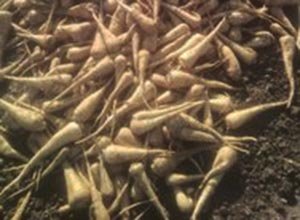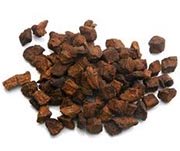Chicory root
Chicory root is the taproot of chicory plant (endive). It found widespread use as a coffee substitute beginning in the 17th century. The demand for root chicory rose to an all-time high during the Second World War when the coffee beans supply mismatch was apparent due to increased demand by many European countries.
Scientific name: Cichorium intybus var. Sativum.
 |
| Root Chicory |
Chicory is a cool-season perennial herb but cultivated as a biennial for its taproots. It is best grown in deep, well-drained fertile soils to encourage deep rooting when forced for the roots. It bears distinctive light-blue flowers that attract insects like bumblebees.
Chicory plant features dandelion-like toothed leaves, and bears relatively large, brown, fleshy, dandelions-like taproot with a milky sap.
During harvest, the entire plant, along with its taproot, was dug using machines. Smaller chicory, however, can be pulled (uprooting) as in carrots. The root measures about 5 cm in diameter at the crown end and 15-20 cm in length, which tapers as in other taproots and weighs 50-100 g.
12 Unique Health Benefits of Chicory Root
Root chicory is low in calories; 100 g of raw taproot carries 72 calories. There is no cholesterol and carries just traces of saturated fats in the root. Nonetheless, it contains several health-benefiting plant-derived compounds, minerals, and vitamins.
Chicory root does not contain caffeine. It is added to regular coffee grounds to reduce the total amount of caffeine in coffee drinks. Regular consumption of chicory infusion itself offers more benefits than regular coffee.
It contains a number of medicinally important phytochemicals such as inulin, sesquiterpene lactones, alkaloids, polyphenol pigments, plant sterols, saponins, and tannins. Consumption of pure chicory infusion works as aperient (relieve constipation) and depurative (purifying and detoxifying effects).
Chicory is the natural source soluble dietary fibers like inulin. Inulin and other fructans in chicory root have prebiotic properties which encourage the growth of beneficial micro-flora inside the gut and inhibition of harmful bacteria.
Dietary fibers and inulin in root chicory reduce the absorption of LDL-lipoproteins and cholesterol from the food. It, thereby reduces the risk of high cholesterol levels in the blood.
Inulin and other soluble fibers (fructans) enhance the absorption of minerals (zinc, calcium, and iron), and vitamins from diet.
Root chicory, like lettuce, is one of the richest sources of sesquiterpene lactones, Sesquiterpene lactones confer the bitter flavor taste to foods such as chicory. These compounds have been found to have anti-tumor and anti-inflammatory properties.
Consumption of chicory tea is often recommended in traditional medicines to stimulate bile secretion and improve digestion.
Sesquiterpene lactone bitter substances like lactucopicrin (Intybin) have a sedative and tonic effect on the central nervous system. It thus relaxes instead of stimulating the effects of caffeine.
Soluble dietary fibers cut down sugar absorption in the gut and help reduce blood sugar levels in diabetes. It also reduces colonic cancer risk by decreasing the content of toxic metabolites like ammonia in humans.
Further, the root infusion contains modest amounts of minerals like iron (10%), manganese, phosphorus, etc, and vitamins like pyridoxine (vitamin B-6).
The root extract has anti-parasitic (anthelmintic) properties. Chicory plant/root forage employed as cattle feed to eradicate worm infestation.
| Principle | Nutrient Value | Percent of RDA |
|---|---|---|
| Energy | 72 Kcal | 3.5% |
| Carbohydrates | 17.51 g | 14% |
| Protein | 1.40 g | 3% |
| Total Fat | 0.20 g | <1% |
| Cholesterol | 0 mg | 0% |
| Dietary Fiber | 1.5 g | 4% |
| Vitamins | ||
| Folates | 23 µg | 6% |
| Niacin | 0.400 mg | 2.5% |
| Pyridoxine | 0.241 mg | 18% |
| Riboflavin | 0.030 mg | 2% |
| Thiamin | 0.040 mg | 3% |
| Vitamin A | 6 IU | 0% |
| Vitamin C | 5 mg | 8% |
| Electrolytes | ||
| Sodium | 50 mg | 3% |
| Potassium | 290 mg | 6% |
| Minerals | ||
| Calcium | 36 mg | 3.5% |
| Iron | 0.80 mg | 10% |
| Magnesium | 22 mg | 5.5% |
| Manganese | 0.233 mg | 10% |
| Phosphorus | 61 mg | 9% |
| Selenium | 0.7 µg | 1% |
| Zinc | 0.33 mg | 3% |
Selection
 |
| rosted chicory chunks |
Some home gardeners grow fresh roots and preserve them for instant brewing. In the supermarkets, however, fresh chicory root is not readily found; instead, processed forms such as milled (ground) powder, granules, flakes, extracts, etc., can be found easily. Choose a fresh product and check for authenticity.
Dried roots keep well for several months. Store fresh powder/flakes/cubes in airtight containers away from direct sunlight. Use it as early as possible to avoid loss of flavor and essential oils.
Preparation and serving methods
 |
| Chicory coffee Photo: Alvin Wong. |
If you grow chicory in your backyard, gather the roots and seeds. Wash in cold water; scrubbing is not necessary. Trim the ends and cut them into cubes, or scrape them into thin slices (flakes). Dry slowly in the sun. The products can be roasted as and when required just before brewing into tea or adding to coffee as a blend. Infusion gives coffee a bitter taste and dark color.
Here are some serving tips:
Roasted and ground, chicory root, and seeds chiefly employed as a mix to coffee powder to brew coffee.
Chicory root infusion is a caffeine-free healthy drink. It is safe and has a milder effect on the nervous system. Unlike coffee, it does not stimulate the heart and cause palpitations.
It can be blended with dandelion root is an herbal extraction for healthy skin and antioxidant benefits.
The root can be added to flavor soft drinks and steeped and added milk as a flavorful drink, chicory latte.
Safety profile
Chicory root, if used alone, is a caffeine-free food item that can be consumed by children as well as adults alike as a healthy herbal drink. It can also be added to the regular coffee powder to reduce the total amount of caffeine in coffee.
The chicory plant and its parts may cause hypersensitivity reactions manifesting as itching, allergic contact dermatitis, redness in eyes, etc. when handled by some sensitive individuals. Its excessive use can lead to digestive problems due to high inulin composition. (Medical disclaimer).
Also read ≻≻-
≻≻-Chicory greens nutition facts and Health beenfits.
≻≻- Herbal teas for an impressive list of herbal teas with complete illustrations of their nutrition facts and health benefits.
≻≻-Back to Herbs from Chicory root. Visit here for an impressive list of vegetables with complete illustrations of their nutrition facts and health benefits.
≻≻-Back to Home page.
Further reading: